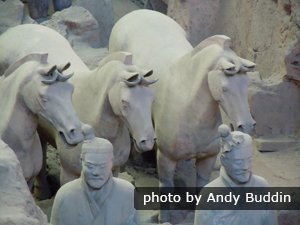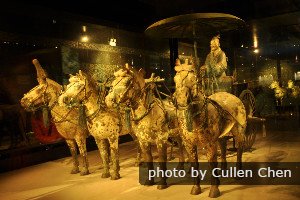Uncovers the Mystery of the Ancient Army Array
 Warriors and horses in vault two form a rigorous battle array.
Warriors and horses in vault two form a rigorous battle array.
Excavation and restoration is still ongoing at vaults two and three.
Excavated in 1976, Pit 2 stands about 20 meters north to Pit 1. As the highlight of the whole mausoleum, it uncovers the mystery of the ancient army array. It consists of four units, measuring 94 meters east to west and 84 meters south to north and 5 meters deep., forming a 6000 sq. meter built-up area.
The first unit contains rows of kneeling and standing archers; the second one is a chariot war array; the third unit consists of mixed forces with infantry, chariot and trooper standing in rectangular array; and the last one includes numerous troopers holding weapons. The four units form a rigorous battle array.
Pit 3 - Represents the Command Post
Vault Three is the smallest one. There are only 68 terracotta warriors figures, many of which are without heads. It's obvious that Vault Three represents the command post, as all the figures are officials.
The Exhibition of Bronze Chariots
 The Bronze Chariot Exhibition
The Bronze Chariot Exhibition
The two bronze carriages displayed in the hall were discovered 20 meters from the west side of the Tomb of Qin Shihuang in December 1980, and were elaborately restored before exhibition.
The carriages have about 3,400 parts each and were driven by four horses. The second one is 3.17meters long and 1.06 meters high. The bronze horses vary from 65 cm to 67 cm high and 120 cm long. Each weighs 1,234 kg in total.
They were mainly made of bronze, but there were 1,720 pieces of golden and silver ornaments, weighting 7 kg, on each carriage. The carriages were so well-made, and so vivid, that they boast being the best-preserved and having the highest rank among the earliest known bronze relics in China. These chariots are the biggest pieces of ancient bronzeware ever found in the world.
No comments:
Post a Comment